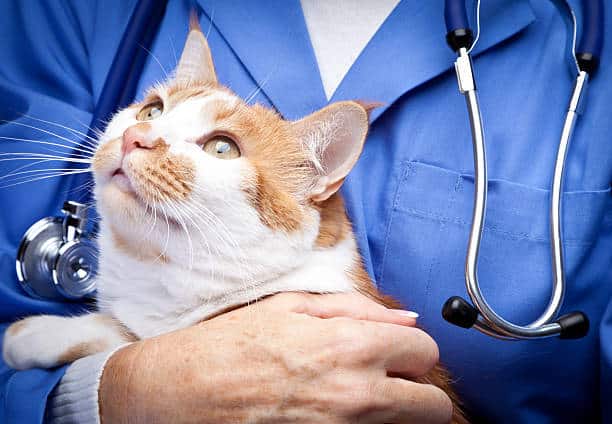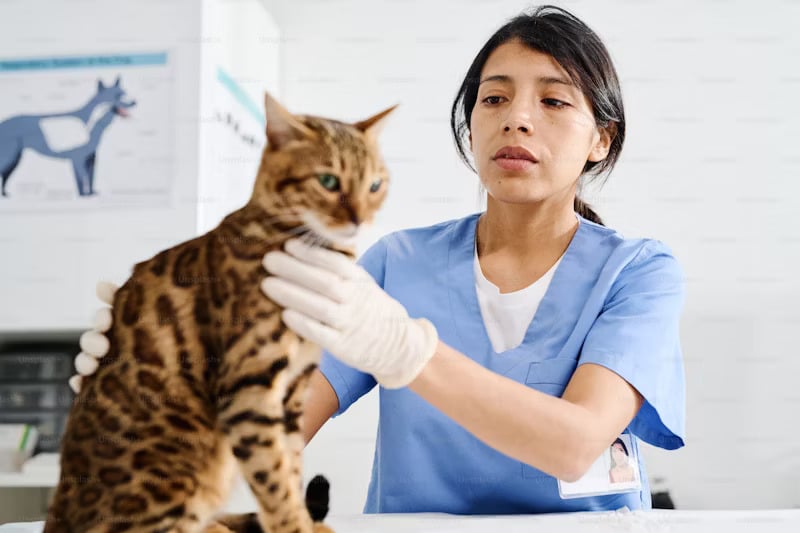Diving into the world of feline care, have you ever spotted those mystifying black specks in your kitty’s coat and thought, “Is this the latest cat fashion trend or a cry for help?”
Turns out, cat black dandruff is a real thing, and it’s neither trendy nor particularly glamorous. This article sheds light on the shadowy world of cat black dandruff, revealing the signs, causes, and the ultimate question: is it a harmless flake-off or a flea fiesta?
Keep reading to discover the short answer to black dandruff mysteries and why this might just be the purr-fect read for concerned cat parents.
[ez-toc initial_view=”hide”]
Identifying Cat with Dandruff or Dander

Signs and Symptoms
An important step in identifying black dandruff in your cat is to observe the signs and symptoms. Keep an eye out for dark flakes in your cat’s fur, especially along the back, neck, and tail areas. These flakes may look similar to regular dandruff but will have a darker color, often appearing black or dark brown.
Additionally, you may notice your cat scratching excessively or developing skin irritation in the affected areas. If you observe these signs, it’s crucial to consult a veterinarian for a proper diagnosis and treatment plan.
Cat Dandruff or Flea Dirt? or Cat Dander? Differentiating from Flea Dirt
When dealing with black specks in your cat’s fur, it’s important to differentiate between black dandruff and flea dirt.
While both may look similar at first glance, there are key differences to watch out for.
Flea dirt, which is actually flea feces, tends to have a more uniform shape and size compared to the irregular flakes of black dandruff.
To distinguish between the two, place a few specks on a damp paper towel – flea dirt will release a reddish-brown color due to the blood content, while black dandruff will not.
If you are unsure, seek advice from your veterinarian for proper identification and treatment.
Why is My Black Cat’s Coat Turning Brown? 3 Causes of Cat Dandruff
1. Environmental and Dietary Factors
Little changes in your pet’s environment or diet can lead to black dandruff. Dry air, lack of hydration, or nutrient deficiencies can contribute to flaky skin. Making sure your cat has access to fresh water and a balanced diet rich in necessary fatty acids can help improve skin health.
Additionally, using a humidifier in dry indoor environments can help combat dry skin.
- Dry air and lack of hydration can contribute to black dandruff
- Nutrient deficiencies may cause flaky skin issues
- Ensuring access to fresh water and a balanced diet can improve skin health
Knowing the environmental triggers and adjusting your animal’s diet can play a significant role in combating black dandruff.
2. Parasitic Infections and Allergies
Dietary imbalances or food allergies can trigger black dandruff in cats. Poor quality food lacking necessary nutrients can result in skin issues. Additionally, food allergies can manifest as skin problems, leading to excessive shedding of dark flakes on your cat’s coat.
This emphasizes the importance of providing a well-balanced diet tailored to your cat’s nutritional needs and identifying and eliminating any potential allergens from their food.
3. Underlying Health Conditions
For instance, hormonal imbalances, thyroid issues, or autoimmune diseases can also cause black dandruff in cats. These conditions disrupt the normal skin cell turnover process, leading to an accumulation of dead skin cells and flakiness in the coat. If left untreated, these underlying health issues can worsen dandruff problems in your cat.
How Vets Diagnose If My Cat may have Dandruff? Treatment and Management
1. Professional Diagnosis and Veterinary Care

Keep in mind that the first step in addressing black dandruff in your cat is seeking professional veterinary care. The veterinarian will conduct a thorough examination to determine the underlying cause of the issue. This may involve skin tests, blood work, or other diagnostic procedures to pinpoint the root of the problem.
Based on the diagnosis, your vet will recommend tailored treatment options to alleviate the symptoms and promote a healthier skin and coat for your feline companion.
2. Home Care: Shampoos and Diet Adjustments

With black dandruff, home care can play a significant role in managing the condition. Professional guidance might include the use of medicated shampoos designed to soothe irritated skin and reduce flakiness.
Alongside this, diet adjustments may be recommended to ensure your cat is receiving adequate nutrition to support healthy skin and coat.
By following these recommendations diligently, you can help improve your cat’s skin condition and overall well-being.
Professional diagnosis and veterinary care are imperative in addressing dandruff. Your veterinarian can provide specific guidance on the most effective parasite control strategies based on your cat’s unique situation.
By following their recommendations for flea prevention, treatment, and environmental control, you can help eliminate the source of black dandruff and promote a healthier coat for your feline friend.
If you are brshing off dandruff stop. Don’t Brush Off Feline Dandruff Read More
Parasite Control Strategies

Control of parasites like fleas and mites is crucial in managing black dandruff. These pesky creatures can exacerbate skin issues and contribute to the presence of dark flakes in your cat’s fur. Implementing regular flea prevention measures, such as topical treatments, oral medications, or environmental sprays, can help keep parasites at bay.
Additionally, maintaining a clean living environment and regularly grooming your cat can aid in preventing reinfestation.
For instance, your veterinarian may recommend a combination of topical flea treatments and environmental decontamination to effectively address fleas and mites. By following these strategies consistently, you can help reduce the risk of black dandruff reoccurring and ensure your cat’s skin remains healthy and flake-free.
How to Get Rid of Dandruff ? Prevention and Long-Term Health
Routine Grooming and Skincare

To prevent black dandruff in your cat, it is important to establish a regular grooming routine. Brushing your cat’s coat not only helps distribute natural oils and remove dead skin cells but also allows you to inspect for any signs of dandruff or parasites.
Additionally, using a moisturizing shampoo specifically designed for cats can help keep their skin hydrated and less prone to flakiness.
Regular Veterinary Check-ups and Vaccinations

Prevention is key when it comes to maintaining your cat’s long-term health. Schedule regular veterinary check-ups to monitor your cat’s overall well-being and catch any potential issues early on. Vaccinations play a crucial role in preventing common feline diseases that can compromise your cat’s immune system and skin health
The bottom line
Now, understanding the concerns surrounding cat black dandruff is crucial for proactive pet care. These dark flakes in your cat’s fur can stem from various factors, including skin issues, parasites, allergies, or health conditions. To address this problem effectively, it’s crucial to consult a veterinarian for a proper diagnosis and treatment plan.
By identifying the root cause and implementing the recommended solutions, you can help your feline companion regain a healthy, flake-free coat. Do not forget, prompt action and expert guidance are key to ensuring your cat’s well-being and comfort.
FAQ
Q: What is black dandruff or white flakes in cats?
A: Black or white dandruff in cats refers to dark flakes seen in a cat’s coat, usually indicating accelerated shedding of dead skin cells. It can be caused by various factors such as dry skin from environmental conditions, diet, parasites like fleas or mites, food allergies, or underlying health issues.
Q: How can I differentiate black dandruff from flea dirt?
A: To differentiate black dandruff from flea dirt, observe whether the specks move or jump. If they do, they are likely fleas. Flea dirt consists of tiny black or brown flecks which are actually flea feces. It’s vital to rule out fleas before addressing black dandruff concerns.
Q: How should I address black dandruff in my cat?
A: The best course of action to address black dandruff in your cat is to consult a veterinarian. A vet can diagnose the underlying cause and recommend appropriate treatment, which may involve medicated shampoos, dietary modifications, parasite control, or addressing any health issues contributing to the dandruff. With timely veterinary intervention, you can help your cat regain a healthy, flake-free coat.
Q: What are the black specks on my cat’s fur?
A: The black specks on your cat’s fur could be a sign of cat dandruff, which is often characterized by flaky skin and dry skin.
Q: How can I get rid of cat dandruff?
A: To get rid of cat dandruff, make sure to brush your cat regularly, ensure a balanced diet with proper cat food, and use dandruff shampoo specifically designed for cats.
Q: Can cats get dandruff like humans?
A: Yes, cats can get dandruff just like humans. It can be caused by various factors such as dry skin, flea infestation, or poor grooming habits.
Q: What causes black flakes on the base of my cat’s tail?
A: Black flakes on the base of the tail of your cat could indicate dandruff, which may be caused by flea infestation, poor diet, or other underlying skin conditions.
Q:My cat has dandruff How do flea infestations contribute?
A: Flea infestations can lead to cat dandruff as flea bites and flea eggs can irritate the skin, causing dryness and flakiness leading to white flakes
Q: Can overweight cats develop dandruff?
A: Yes, overweight cats are more prone to developing dandruff due to difficulties in grooming themselves properly, which can lead to dry skin and flakiness.
Q: Is there a connection between cat grooming and dandruff?
A: Yes, proper cat grooming plays a crucial role in preventing and managing cat dandruff. Regular grooming helps in distributing natural oils and removing dead skin cells that contribute to dandruff.
Your veterinarian can provide tailored advice on vaccination schedules based on your cat’s lifestyle and risk factors.
How do I get rid of black cat dandruff?
Get Rid of Black Cat Dandruff:
- Brush Regularly: Helps remove flakes and distribute skin oils.
- Proper Diet: Rich in omega-3 fatty acids for skin health.
- Hydrate: Ensure access to fresh water.
- Humidify: Use a humidifier to prevent dry skin.
- Veterinary Consult: For medicated shampoos or specific treatments.
- Flea Control: If caused by flea dirt, implement regular flea treatment.
Why does my cat have black flakes in his fur?
Reasons for Black Flakes in Cat’s Fur:
- Flea Dirt: Indicates flea infestation.
- Skin Infections: Fungal or bacterial can cause discoloration.
- Environmental Factors: Dry air, allergens.
- Dietary Issues: Lack of essential nutrients.
What is the black stuff on my cat’s skin?
Black Stuff on Cat’s Skin:
- Flea Dirt: Flea feces, indicating infestation.
- Skin Conditions: Fungal infections, scabbing.
- Environmental Dirt: Accumulated grime.
Is cat dandruff harmful?
Cat Dandruff Harmfulness:
- Generally Not Harmful: Often cosmetic, not directly harmful.
- Underlying Issues: Can indicate health problems needing attention.
- Skin Irritation: May cause discomfort or itchiness for the cat.
